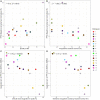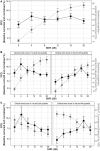Impact of SNR, peripheral auditory sensitivity, and central cognitive profile on the psychometric relation between pupillary response and speech performance in CI users
- PMID: 38188029
- PMCID: PMC10768066
- DOI: 10.3389/fnins.2023.1307777
Impact of SNR, peripheral auditory sensitivity, and central cognitive profile on the psychometric relation between pupillary response and speech performance in CI users
Abstract
Despite substantial technical advances and wider clinical use, cochlear implant (CI) users continue to report high and elevated listening effort especially under challenging noisy conditions. Among all the objective measures to quantify listening effort, pupillometry is one of the most widely used and robust physiological measures. Previous studies with normally hearing (NH) and hearing-impaired (HI) listeners have shown that the relation between speech performance in noise and listening effort (as measured by peak pupil dilation) is not linear and exhibits an inverted-U shape. However, it is unclear whether the same psychometric relation exists in CI users, and whether individual differences in auditory sensitivity and central cognitive capacity affect this relation. Therefore, we recruited 17 post-lingually deaf CI adults to perform speech-in-noise tasks from 0 to 20 dB SNR with a 4 dB step size. Simultaneously, their pupillary responses and self-reported subjective effort were recorded. To characterize top-down and bottom-up individual variabilities, a spectro-temporal modulation task and a set of cognitive abilities were measured. Clinical word recognition in quiet and Quality of Life (QoL) were also collected. Results showed that at a group level, an inverted-U shape psychometric curve between task difficulty (SNR) and peak pupil dilation (PPD) was not observed. Individual shape of the psychometric curve was significantly associated with some individual factors: CI users with higher clinical word and speech-in-noise recognition showed a quadratic decrease of PPD over increasing SNRs; CI users with better non-verbal intelligence and lower QoL showed smaller average PPD. To summarize, individual differences in CI users had a significant impact on the psychometric relation between pupillary response and task difficulty, hence affecting the interpretation of pupillary response as listening effort (or engagement) at different task difficulty levels. Future research and clinical applications should further characterize the possible effects of individual factors (such as motivation or engagement) in modulating CI users' occurrence of 'tipping point' on their psychometric functions, and develop an individualized method for reliably quantifying listening effort using pupillometry.
Keywords: CI; cognitive abilities; listening effort; pupillometry; speech performance.
Copyright © 2023 Zhang, Callejón-Leblic, Picazo-Reina, Blanco-Trejo, Patou and Sánchez-Gómez.
Conflict of interest statement
YZ and FP are employees of Oticon Medical, manufacturer of the cochlear implants used by the patients in this study and receive salaries as part of their employment. MC-L’s research is funded by a Torres Quevedo grant from the Spanish Ministry of Science and Innovation (PTQ 2019-010594/AEI/10.13039/501100011033) and co-funded by Oticon Medical. The remaining authors declare that the research was conducted in the absence of any commercial or financial relationships that could cause a potential conflict of interest.
Figures






Similar articles
-
Listening Effort Measured With Pupillometry in Cochlear Implant Users Depends on Sound Level, But Not on the Signal to Noise Ratio When Using the Matrix Test.Ear Hear. 2024 Nov-Dec 01;45(6):1461-1473. doi: 10.1097/AUD.0000000000001529. Epub 2024 Jun 18. Ear Hear. 2024. PMID: 38886888 Free PMC article.
-
Speech Recognition and Listening Effort in Cochlear Implant Recipients and Normal-Hearing Listeners.Front Neurosci. 2022 Feb 10;15:725412. doi: 10.3389/fnins.2021.725412. eCollection 2021. Front Neurosci. 2022. PMID: 35221883 Free PMC article.
-
Pupillometry Assessment of Speech Recognition and Listening Experience in Adult Cochlear Implant Patients.Front Neurosci. 2020 Nov 6;14:556675. doi: 10.3389/fnins.2020.556675. eCollection 2020. Front Neurosci. 2020. PMID: 33240035 Free PMC article.
-
Time-specific Components of Pupil Responses Reveal Alternations in Effort Allocation Caused by Memory Task Demands During Speech Identification in Noise.Trends Hear. 2023 Jan-Dec;27:23312165231153280. doi: 10.1177/23312165231153280. Trends Hear. 2023. PMID: 36938784 Free PMC article. Review.
-
A Multimodal Approach to Measuring Listening Effort: A Systematic Review on the Effects of Auditory Task Demand on Physiological Measures and Their Relationship.Ear Hear. 2024 Sep-Oct 01;45(5):1089-1106. doi: 10.1097/AUD.0000000000001508. Epub 2024 Jun 17. Ear Hear. 2024. PMID: 38880960 Free PMC article.
Cited by
-
Reduced listening effort with adaptive binaural beamforming in realistic noisy environments.Sci Rep. 2025 May 23;15(1):17998. doi: 10.1038/s41598-025-95045-3. Sci Rep. 2025. PMID: 40410503 Free PMC article.
-
Cochlear-implant dichotic listening performance and effort are disrupted with functional ear asymmetry.J Acoust Soc Am. 2025 Apr 1;157(4):2905-2920. doi: 10.1121/10.0036440. J Acoust Soc Am. 2025. PMID: 40243393
References
LinkOut - more resources
Full Text Sources
Miscellaneous

